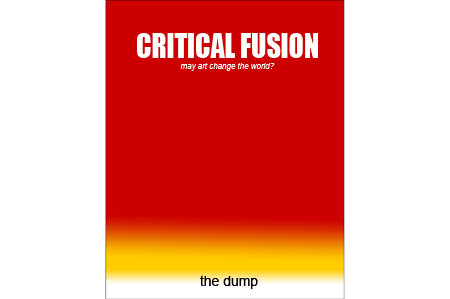
Confronté à la difficulté de nommer une évolution significative des pratiques dans lesquelles mon travail s’inscrit, j’ai compris qu’il faudrait que j’explicite le concept métaphorique auquel je suis parvenu : La Fusion Critique.
Pour que ce concept soit compris, il n’y a d’autre solution que d’en rédiger le manifeste ou plutôt d’en manifester la rédaction. Or s’il est un terrain où la réalisation m’est difficile, c’est celui qui fait passer l’écrit avant l’acte, quelque laconique que soit le premier et quelque fugace que puisse être le second. Il faut donc que je me résigne à soumettre au Dump ce projet d’ouvrage théorique qui ne m’en paraît pas moins essentiel.
Le point de départ de la réflexion venait de la difficulté que j’éprouvais à définir le point de rencontre entre mon travail sur l’immersion, rendue possible par la réalité virtuelle, et mon intérêt pour agir sur le monde réel, l’espace physique et le social. La frontière commune entre ces deux pratiques n’avait bien entendu rien à voir avec la technologie qui semblait les séparer mais probablement plus avec le concept de situation que les deux mettent en œuvre.
Quand ils ne se satisfont pas de la simulation, les environnements virtuels rendent possible la mise en situation symbolique (World Skin, le Tunnel sous l‘Atlantique, Crossing Talks, les Grandes Questions…). Dans les années 80, la vidéo me permettait de mettre mes interlocuteurs (B. Lavier, J.-M. Alberola, J. Le Gac, Takis, B. Woodrow, M. Raysse, J.-L. Vilmouth etc.) en des situations qui créaient la même incertitude, la même indétermination relative que les mondes virtuels sur le devenir scénaristique du résultat. Plus tard, c’est curieusement la réalité virtuelle qui a réveillé en moi le désir de réactiver cette capacité qu’a le monde réel de révéler ses limites à l’occasion de la rencontre non fortuite avec un catalyseur symbolique.
Le virtuel n’existe que par la définition des règles qui le régissent. Les fictions se multiplient qui substituent au scénario pré-écrit, vestiges adulés d’un déterminisme historique, un ensemble de règles regroupées dans « la Bible » (c’est bien ainsi que l’on nomme en animation, l’ensemble des règles graphiques, comportementales et scénaristiques, qui donnent au film ou à la série d’animation sa cohérence).
Les reality shows sont de cet ordre qui lâchent les volontaires motivés tels des souris de laboratoire dans des univers précontraints. Je nomme FUSION l’introduction de la fiction dans la matière même du réel. L’immersion permet l’irruption du spectateur/réel dans la fiction, la fusion inverse le processus en introduisant la fiction dans la réalité. La téléréalité relève de la fusion. On comprend aussi que les titres tournoyant en 3D de CNN annonçant les derniers épisodes de la guerre du Golfe contribuaient à créer la confusion dans ce mixage souvent discutable entre les deux registres de la fiction et de l’information. La société du spectacle commence probablement là où notre capacité de discernement se trouve prise en défaut. Pourtant les indices nous portent à croire que l’acculturation empirique des habitants de la planète informationnelle leur permet d’imaginer, à la première vision, que les images d’avions s’écrasant sur les tours du World Trade Center sont probablement extraites du dernier film d’action hollywoodien. Il est probablement bon signe que nous activions naturellement notre incrédulité là où les générations précédentes auraient, en complices consommés du spectacle triomphant, appliqué la nécessaire mais vulnérable « suspension of disbelief ». Il est tout aussi rassurant que nous puissions ensuite nous rendre à l’évidence : au-delà de l’enjeu et des conséquences humaines et historiques, le 11 septembre marque le climax d’un phénomène dont il faudra prendre la mesure: la possibilité généralisée d’une écriture symbolique dans la matière même du monde. Que le point d’appui soit des tours jumelles et le levier la puissance des médias internationaux n’enlève rien à la réalité du geste qui soulève le monde. Plus que la chair ce sont les esprits qui sont frappés et c’est l’époque qui rend la chose possible.
Dans le champ artistique les exemples se multiplient à la vitesse du réseau, condition parfois nécessaire mais rarement suffisante de la pratique de la fusion critique. Des Yes Men à Stelarc, des hackers à Banksi, les formes et les terrains sont ouverts. De l’espace public à l’intérieur du corps, de la façade des immeubles aux ramifications du réseau… ils couvrent le champ de l’activité humaine et de l’espace social introduisant des indices, des clefs de décryptage, des moments de doute et de questionnement. La Fusion Critique se distingue dans l’intention des pratiques illusionnistes et formelles, qui se satisferaient du spectaculaires ou du ludique sans en tirer parti pour donner à lire le monde. Pour les mêmes raisons, dans l’idée d’agir sur le monde à son échelle, l’artiste n’exclue aucune de ces dimensions de sa panoplie de crise.
A la différence de la FUSION qui trahit l’effet par l’intention, la FUSION CRITIQUE – contraction métaphorique de la MASSE CRITIQUE qui fragilise l’équilibre atomique et de la FUSION NUCLEAIRE susceptible d’apporter une puissance énergétique, certes dévastatrice, mais incomparable – traduit une action symbolique fondée sur l’intrusion de la fiction dans le réel à des fins critiques. C’est la finalité qui fait la différence. En substituant la révélation (décryptage) à la distraction (Entertainment), la FUSION CRITIQUE apporte à la notion de situation un contexte d’application hautement réaliste.



 (2 votes, average: 3, 50 out of 5)
(2 votes, average: 3, 50 out of 5)